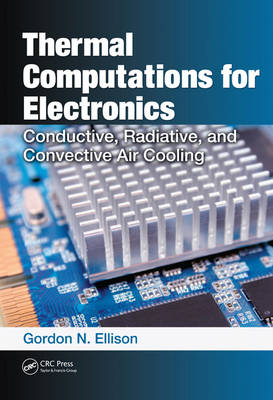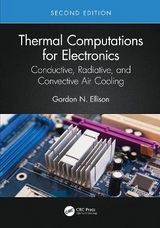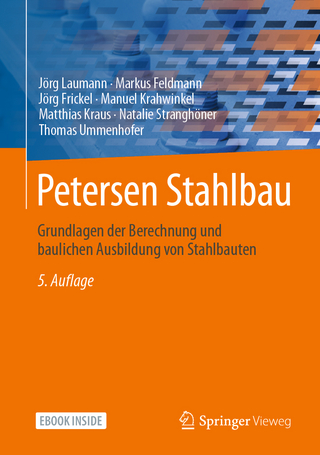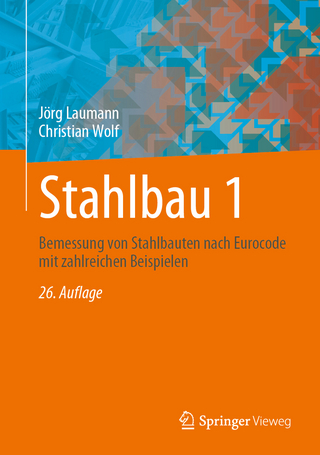
Thermal Computations for Electronics
Crc Press Inc (Verlag)
978-1-4398-5017-6 (ISBN)
- Titel erscheint in neuer Auflage
- Artikel merken
The beginning of this book is largely devoted to prediction of airflow and well-mixed air temperatures in systems and heat sinks, after which it explores convective heat transfer from heat sinks, circuit boards, and components. Applying a systematic presentation of information to enhance understanding and computational practice, this book:
Provides complete mathematical derivations and supplements formulae with design plots
Offers complete exercise solutions (Mathcad™ worksheets and PDF images of Mathcad worksheets), lecture aids (landscape-formatted PDF files), and text-example Mathcad worksheets for professors adopting this book
Addresses topics such as methods for multi-surface radiation exchange, conductive heat transfer in electronics, and finite element theory with a variational calculus method explained for heat conduction
Presents mathematical descriptions of large thermal network problem formulation
Discusses comprehensive thermal spreading resistance theory, and includes steady-state and time-dependent problems
This reference is useful as a professional resource and also ideal for use in a complete course on the subject of electronics cooling, with its suggested course schedule and other helpful advice for instructors. Selected sections may be used as application examples in a traditional heat transfer course or to help professionals improve practical computational applications.
Gordon N. Ellison has a BA in Physics from the University of California at Los Angeles (UCLA) and an MA in Physics from the University of Southern California (USC). His career in thermal engineering includes eight years as a Technical Specialist at NCR and 18 years at Tektronix, Inc., retiring from the latter as a Tektronix Fellow. Over the last 15 years Mr. Ellison has been an independent consultant and has also taught the course, Thermal Analysis for Electronics, at Portland State University, Oregon. He has also designed and written several thermal analysis computer codes.
Introduction
Primary mechanisms of heat flow
Conduction
Application example: Silicon chip resistance calculation
Convection
Application example: Chassis panel cooled by natural convection
Radiation
Application example: Chassis panel cooled only by radiation 7
Illustrative example: Simple thermal network model for a heat sinked power transistor
Illustrative example: Thermal network circuit for a printed circuit board
Compact component models
Illustrative example: Pressure and thermal circuits for a forced air cooled enclosure
Illustrative example: A single chip package on a printed circuit board—the problem
Illustrative example: A single chip package on a printed circuit board—Fourier series solution
Illustrative example: A single chip package on a printed circuit board—thermal network solution
Illustrative example: A single chip package on a printed circuit board—finite element solution
Illustrative example: A single chip package on a printed circuit board—methods compared
Thermodynamics of airflow
The first law of thermodynamics
Heat capacity at constant volume
Heat capacity at constant pressure
Steady gas flow as an open, steady, single stream
Air temperature rise: Temperature dependence
Air temperature rise: T identified using differential forms of ΔT,ΔQ
Air temperature rise: T identified as average bulk temperature
Airflow I: Forced flow in systems
Preliminaries
Bernoulli’s equation
Bernoulli’s equation with losses
Fan testing
Estimate of fan test error accrued by measurement of downstream static pressure
Derivation of the "one velocity" head formula
Fan and system matching
Adding fans in series and parallel
Airflow resistance: Common elements
Airflow resistance: True circuit boards
Modeled circuit board elements
Combining airflow resistances
Application example: Forced air cooled enclosure
Airflow II: Forced flow in ducts, extrusions, and pin fin arrays
The airflow problem for channels with a rectangular cross-section
Entrance and exit effects for laminar and turbulent flow
Friction coefficient for channel flow
Application example: Two-sided extruded heat sink
A pin fin correlation
Application example: Pin fin problem from Khan, et al.
Flow bypass effects according to Lee
Application example: Flow bypass method using Muzychka and Yovanovich correlation
Application example: Flow bypass method using HBT friction factor correlation
Flow bypass effects according to Jonsson and Moshfegh
Application example: Pin fin problem using Jonsson and Moshfegh correlation
Airflow III: Buoyancy driven draft
Derivation of buoyancy driven head
Matching buoyancy head to system
Application example: Buoyancy-draft cooled enclosure
System models with buoyant airflow
Forced convective heat transfer I: Components
Forced convection from a surface
The Nusselt and Prandtl numbers
The Reynold’s number
Classical flat plate forced convection correlation: Uniform surface temperature, laminar flow
Empirical correction to classical flat plate forced convection
correlation, laminar flow
Application example: Winged aluminum heat sink
Classical flat plate forced convection correlation: Uniform heat rate per unit area, laminar flow
Classical flat plate (laminar) forced convection correlation extended to small Reynold’s number
Circuit boards: Adiabatic heat transfer coefficients and adiabatic temperatures
Adiabatic heat transfer coefficient and temperature according to M. Faghri, et al.
Adiabatic heat transfer coefficient and temperature according to R. Wirtz
Application example: Circuit board with 1.5 in. / 1.5 in. / 0.6 in. convecting modules
Application example: Circuit board with 0.82 in./ 0.24 in. /0.123 in. convecting modules
Forced convective heat transfer II: Ducts, extrusions, and pin fin arrays
Boundary layer considerations
A convection/conduction model for ducts and heat sinks
Conversion of an isothermal heat transfer coefficient referenced to inlet to referenced to local air
Nusselt number for fully developed laminar duct flow corrected for entry length effects
A newer Nusselt number for laminar flow in rectangular (cross-section) ducts
Nusselt number for turbulent duct flow
Application example: Two-sided extruded heat sink
Flow bypass effects according to Jonsson and Moshfegh
Application example: Heat sink in a circuit board channel using the flow bypass method of Lee
In-line and staggered pin fin heat sinks
Application example: Thermal resistance of a pin fin heat sink
Natural convection heat transfer I: Plates
Nusselt and Grashof numbers
Classical flat plate correlations
Small device flat plate correlations
Application example: Vertical convecting plate
Application example: Vertical convecting and radiating plate
Vertical parallel plate correlations applicable to circuit board channels
Application example: Vertical card assembly
Recommended use of vertical channel models in sealed and vented enclosures
Conversion of heat transfer coefficients referenced-to-inlet air to referenced-to-local air
Application example: Enclosure with circuit boards - enclosure temperatures only
Application example: Enclosure with circuit boards - circuit board temperatures only
Application example: Enclosure with circuit boards, comparison with CFD
Application example: Single circuit board enclosure with negligible circuit board radiation
Illustrative example: Single circuit board enclosure with radiation exchange between interior enclosure walls and circuit board, results compared with experiment
Illustrative example: Metal walled enclosure with ten circuit boards
Illustrative example: Metal walled enclosure with heat dissipation provided
Natural convection heat transfer II: Heat sinks
Heat sink geometry and some nomenclature
A rectangular U-channel correlation from Van de Pol and Tierney
Design plots representing the Van de Pol & Tierney correlation
A few useful formulae
Application example: Natural convection cooled, vertically oriented heat sink
Application example: Natural convection cooled, nine fin heat sink compared to test data
Thermal radiation heat transfer
Blackbody radiation
Spacial effects and the view factor
Application example: View factors for finite parallel plates
Non-black surfaces
The radiation heat transfer coefficient
Application example: Radiation and natural convection cooled enclosure with circuit boards
Radiation for multiple gray-body surfaces
Hottel script F (F) method for gray-body radiation exchange
Application example: Gray-body circuit boards analyzed as infinite parallel plates
Application example: Gray-body circuit boards analyzed as finite parallel plates
Thermal radiation networks
Thermal radiation shielding for rectangular U-channels (fins)
Application example: Natural convection and radiation cooled heat sink
Application example: Nine fin heat sink, compared with test data
Application example: Natural convection and radiation cooled nine fin heat sink
Illustrative example: Natural convection and radiation cooled heat sink
Conduction I: Some basics
Fourier’s law of heat conduction
Application example: Mica insulator with thermal paste
Thermal conduction resistance of some simple structures
The one-dimensional differential equation for heat conduction
Application example: Aluminum core board with negligible air cooling
Application example: Aluminum core board with forced air cooling
Application example: Simple heat sink
Fin efficiency
Differential equations for more than one dimension
Physics of thermal conductivity of solids
Thermal conductivity of circuit boards (epoxy-glass laminates)
Application example: Epoxy-glass circuit board with copper
Thermal interface resistance
Application example: Contact resistance for an aluminum joint
Conduction II: Spreading resistance
The spreading problem
Fixed spreading angle theories
Circular-source, semi-infinite media solution by Carslaw and Jaeger (1986)
Rectangular-source, time dependent, semi-infinite media solution by Joy & Schlig (1970)
Other circular source solutions
Rectangular source on rectangular, finite-media with one convecting surface: Theory
Rectangular source on rectangular, finite-media: Design curves
Application example: Heat source centered on a heat sink (Ellison, 2003)
Application example: IC chip on an alumina substrate
Rectangular source on rectangular, finite-media with two convecting surfaces: Theory
Exploring the difference between one-sided and two-sided Newtonian cooling
Including the effect of two different ambients to the two-sided spreading theory
Application example: Heat sink with two convecting sides, one finned and one flat
Square source on square, finite-media with one convecting surface - time dependent (Rhee and Bhatt, 2007)
Additional mathematical methods
Thermal networks: Steady-state theory
Illustrative example: A simple steady-state, thermal network problem, solutions compared
Thermal networks: Time-dependent theory
Illustrative example: A simple time-dependent, thermal network problem
Finite difference theory for conduction with Newtonian cooling
Programming the pressure/airflow network problem
Finite element theory - the concept of the calculus of variations
Finite element theory - derivation of the one-dimensional Euler-Lagrange equation
Finite element theory - application of the one-dimensional Euler-Lagrange equation
Finite element theory - derivation of the two-dimensional Euler-Lagrange equation
Finite element theory - application of the Euler-Lagrange equation to two dimensions
Appendices
Bibliography
Index
| Erscheint lt. Verlag | 8.11.2010 |
|---|---|
| Zusatzinfo | 500+; 59 Tables, black and white; 251 Illustrations, black and white |
| Verlagsort | Bosa Roca |
| Sprache | englisch |
| Maße | 178 x 254 mm |
| Gewicht | 885 g |
| Themenwelt | Technik ► Bauwesen |
| Technik ► Elektrotechnik / Energietechnik | |
| ISBN-10 | 1-4398-5017-8 / 1439850178 |
| ISBN-13 | 978-1-4398-5017-6 / 9781439850176 |
| Zustand | Neuware |
| Haben Sie eine Frage zum Produkt? |
aus dem Bereich



